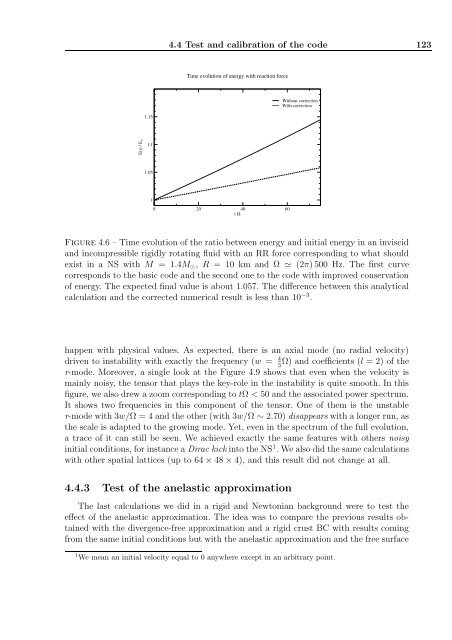Ecole doctorale de Physique de la région Parisienne (ED107)
Ecole doctorale de Physique de la région Parisienne (ED107)
Ecole doctorale de Physique de la région Parisienne (ED107)
You also want an ePaper? Increase the reach of your titles
YUMPU automatically turns print PDFs into web optimized ePapers that Google loves.
E(t) / E 0<br />
1.15<br />
1.1<br />
1.05<br />
1<br />
4.4 Test and calibration of the co<strong>de</strong> 123<br />
Time evolution of energy with reaction force<br />
0 20 40 60<br />
t Ω<br />
Without correction<br />
With correction<br />
Figure 4.6 – Time evolution of the ratio between energy and initial energy in an inviscid<br />
and incompressible rigidly rotating fluid with an RR force corresponding to what should<br />
exist in a NS with M = 1.4M⊙, R = 10 km and Ω (2π) 500 Hz. The first curve<br />
corresponds to the basic co<strong>de</strong> and the second one to the co<strong>de</strong> with improved conservation<br />
of energy. The expected final value is about 1.057. The difference between this analytical<br />
calcu<strong>la</strong>tion and the corrected numerical result is less than 10 −3 .<br />
happen with physical values. As expected, there is an axial mo<strong>de</strong> (no radial velocity)<br />
driven to instability with exactly the frequency (w = 4Ω)<br />
and coefficients (l = 2) of the<br />
3<br />
r-mo<strong>de</strong>. Moreover, a single look at the Figure 4.9 shows that even when the velocity is<br />
mainly noisy, the tensor that p<strong>la</strong>ys the key-role in the instability is quite smooth. In this<br />
figure, we also drew a zoom corresponding to tΩ < 50 and the associated power spectrum.<br />
It shows two frequencies in this component of the tensor. One of them is the unstable<br />
r-mo<strong>de</strong> with 3w/Ω = 4 and the other (with 3w/Ω ∼ 2.70) disappears with a longer run, as<br />
the scale is adapted to the growing mo<strong>de</strong>. Yet, even in the spectrum of the full evolution,<br />
a trace of it can still be seen. We achieved exactly the same features with others noisy<br />
initial conditions, for instance a Dirac kick into the NS1 . We also did the same calcu<strong>la</strong>tions<br />
with other spatial <strong>la</strong>ttices (up to 64 × 48 × 4), and this result did not change at all.<br />
4.4.3 Test of the ane<strong>la</strong>stic approximation<br />
The <strong>la</strong>st calcu<strong>la</strong>tions we did in a rigid and Newtonian background were to test the<br />
effect of the ane<strong>la</strong>stic approximation. The i<strong>de</strong>a was to compare the previous results obtained<br />
with the divergence-free approximation and a rigid crust BC with results coming<br />
from the same initial conditions but with the ane<strong>la</strong>stic approximation and the free surface<br />
1 We mean an initial velocity equal to 0 anywhere except in an arbitrary point.
















